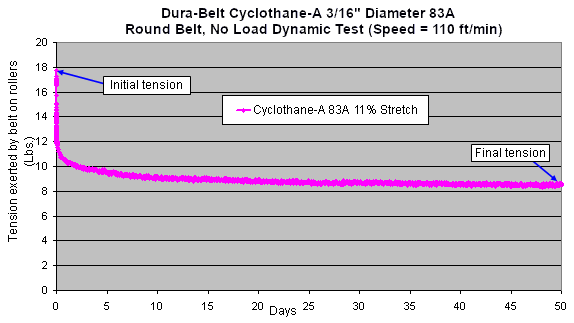Belt Tension Calculator
(Calculates the force exerted by an endless belt on a pulley, i.e., the force of two belt strands)
We recommend stretching most unreinforced round belts at least 5%. The calculated tensions are less accurate above 25% stretch. Usually 83A/85A durometer round belts are stretched 10-12%, and 92A/95A durometer belts are stretched 7-9%. Do not use this calculator to estimate tension for reinforced belts.
|
|
|
|
For wide flat belts, use 75 lbs (333 N) for belt tension.
|
|
Bearing Load: Standard 1.9" (50mm) diameter conveyor rollers are normally rated at 250 lbs (110 kg) maximum load. For idler pulleys the maximum load is determined by the bearings. Our idler pulleys use the 6203 bearing, rated at 600 lbs (270 kg) at typical conveyor speeds. Make sure that your belt tension does not exceed the rating of your application.
If you use multiple belts per roller, use the total of all their tensions to determine the total bearing load when calculating the percent stretch.
*Tension vs. Time: We provide the initial tension so you will know how much force it takes to install the belts. Therefore, do not use it for your tension calculations.
Elastic belt tension declines dramatically after installation. In the first 5 minutes initial tension typically declines by up to 30%. After about a week of run-in, the tension plateaus and remains relatively constant thereafter, declining very slowly at a diminishing rate over time. The chart below shows an example of this under no load. A load can reduce the tension typically by 10% to 30%.
Incidentally, dynamic tension always measures below static tension, so if this test were done without rotating the rollers, the plateaued tension would be about two pounds higher.
 |
Copyright © 2025 Dura-Belt, Inc. All Rights Reserved. Site Index
